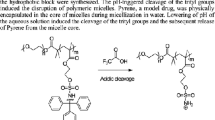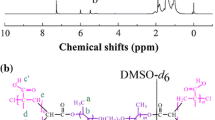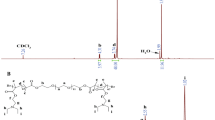Abstract
pH-responsive micelles with a biodegradable PLA core and a mixed PEG/PDPA shell were prepared by self-assembly of poly(ethylene glycol)-b-poly(lactic acid) (PEG-b-PLA) and poly(2-(diisopropylamino)ethyl methacrylate)-b-poly(lactic acid) (PDPA-b-PLA). The micellization status with different pH and the enzyme degradation behavior were characterized by 1H-NMR spectroscopy, dynamic light scattering measurement and zeta potential test. The pH turning point of PDPA block was determined to be in the range of 5.5−7.0. While the pH was above 7.0, the PDPA block collapsed onto the PLA core and could protect the PLA core from invasion of enzyme, as a result, the micelle exhibited a resistance to the enzymatic degradation.
Similar content being viewed by others
References
Veeren, A.; Bhaw-Luximon, A.; Mukhopadhyay, D.; Jhurry, D. Mixed poly(vinyl pyrrolidone)-based drug-loaded nanomicelles shows enhanced efficacy against pancreatic cancer cell lines. Eur. J. Pharm. Sci. 2017, 102, 250–260
Claro, B.; Zhu, K.; Bagherifam, S.; Silva, S. G.; Griffiths, G.; Knudsen, K. D.; Marques, E. F.; Nyström, B. Phase behavior, microstructure and cytotoxicity in mixtures of a charged triblock copolymer and an ionic surfactant. Eur. Polym. J. 2016, 75, 461–473
Tang, M.; Zheng, Q.; Tirelli, N.; Hu, P.; Tang, Q.; Gu, J.; He, Y. Dual thermo/oxidation-responsive block copolymers with self-assembly behaviour and synergistic release. React. Funct. Polym. 2017, 110, 55–61
Balasubramanian, P. V.; Herranz-Blanco, B.; Almeida, P. V.; Hirvonen, J.; Santos, H. A. Multifaceted polymersome platforms: Spanning from self-assembly to drug delivery and protocells. Prog. Polym. Sci. 2016, 60, 51–85
Zhou, L.; Yu, L.; Ding, M.; Li, J.; Tan, H.; Wang, Z.; Fu, Q. Synthesis and characterization of pH-sensitive biodegradable polyurethane for potential drug delivery applications. Macromolecules 2011, 44, 857–864
Qi, X.; Ren, Y.; Wang, X. New advances in the biodegradation of poly(lactic) acid. Int. Biodeter. Biodegr. 2017, 117, 215–223
Shi, Y.; Sun, F.; Wang, D.; Zhang, R.; Dou, C.; Liu, W.; Sun, K.; Li, Y. Enhancement of bioavailability by formulating rhEPO ionic complex with lysine into PEG-PLA micelle. J. Nanopart. Res. 2013, 15, 2002–2011
Garofalo, C.; Capuano, G.; Sottile, R.; Tallerico, R.; Adami, R.; Reverchon, E.; Carbone, E.; Izzo, L.; Pappalardo, D. Different insight into amphiphilic PEG-PLA copolymers: influence of macromolecular architecture on the micelle formation and cellular uptake. Biomacromolecules 2014, 15, 403–415
Kumar, S.; Maiti, P. Controlled biodegradation of polymers using nanoparticles and its application. RSC Adv. 2016, 6, 67449–67480
Wang, Z.; Yu, L.; Ding, M.; Tan, H.; Li, J.; Fu, Q. Preparation and rapid degradation of nontoxic biodegradable polyurethanes based on poly(lactic acid)-poly(ethylene glycol)-poly(lactic acid) and L-lysine diisocyanate. Polym. Chem. 2011, 2, 601–607
Marschutz, M. K.; Bernkop-Schnurch, A. Oral peptide drug delivery: polymer-inhibitor conjugates protecting insulin from enzymatic degradation in vitro. Biomaterials 2000, 21, 1499–1507
Guo, P.; Song, S.; Li, Z.; Tian, Y.; Zheng, J.; Yang, X.; Pan, W. In vitro and in vivo evaluation of APRPG-modified angiogenic vessel targeting micelles for anticancer therapy. Int. J. Pharmaceut. 2015, 486, 356–366
Tangsangasaksri, M.; Takemoto, H.; Naito, M.; Maeda, Y.; Sueyoshi, D. siRNA-loaded polyion complex micelle decorated with charge-conversional polymer tuned to undergo stepwise response to intra-tumoral and intra-endosomal pHs for exerting enhanced RNAi efficacy. Biomacromolecules 2016, 17, 246–255
Guthi, J. S.; Yang, S. G.; Huang, G.; Li, S.; Khemtong, C.; Kessinger, C. W.; Peyton, M.; Minna, J. D.; Brown, K. C.; Gao, J. MRI-visible micellar nanomedicine for targeted drug delivery to lung cancer cells. Mol. Pharmaceut. 2010, 7, 32–40
Moretton, M. A.; Bernabeu, E.; Grotz, E.; Gonzalez, L.; Zubillaga, M.; Chiappetta, D. A. A glucose-targeted mixed micellar formulation outperforms Genexol in breast cancer cells. Eur. J. Pharm. Biopharm. 2017, 114, 305–316
Elsabahy, M.; Wooley, K. L. Design of polymeric nanoparticles for biomedical delivery applications. Chem. Soc. Rev. 2012, 41, 2545–2561
Xu, Y.; Ma, R.; Zhang, Z.; He, H.; Wang, Y.; Qu, A.; An, Y.; Zhu, X. X.; Shi, L. Complex micelles with a responsive shell for controlling of enzymatic degradation. Polymer 2012, 53, 3559–3565
Hu, J.; Liu, G.; Wang, C.; Liu, T.; Zhang, G.; Liu, S. Spatiotemporal monitoring endocytic and cytosolic pH gradients with endosomal esca** pH-responsive micellar nanocarriers. Biomacromolecules 2014, 15, 4293–4301
FitzGerald, P. A.; Gupta, S.; Wood, K.; Perrier, S.; Warr, G. G. Temperature-and pH-responsive micelles with collapsible poly(A -isopropylacrylamide) headgroups. Langmuir 2014, 30, 7986–7992
Guo, X.; Shi, C.; Yang, G.; Wang, J.; Cai, Z.; Zhou, S. Dualresponsive polymer micelles for target-cell-specific anticancer drug delivery. Chem. Mater. 2014, 26, 4405–4418
Gao, W.; Chan, J. M.; Farokhzad, O. C. pH-responsive nanoparticles for drug delivery. Mol. Pharmaceut. 2010, 7, 1913–1920
Dai, Y.; Xu, C.; Sun, X.; Chen, X. Nanoparticle design strategies for enhanced anticancer therapy by exploiting the tumour microenvironment. Chem. Soc. Rev. 2017, 46, 3830–3852
Karimi, M.; Ghasemi, A.; Zangabad, P. S.; Rahighi, R. Smart micro/nanoparticles in stimulus-responsive drug/gene delivery systems. Chem. Soc. Rev. 2016, 45, 1457–1501
Hales, M.; Barner-Kowollik, C.; Davis, T. P.; Stenzel, M. H. Shell-cross-linked vesicles synthesized from block copolymers of poly(D, L-lactide) and poly(A -isopropyl acrylamide) as thermoresponsive nanocontainers. Langmuir 2004, 20, 10809–10817
Wu, C.; Ma, R.; He, H.; Zhao, L.; Gao, H.; An, Y.; Shi, L. Fabrication of complex micelles with tunable shell for application in controlled drug release. Macromol. Biosci. 2009, 9, 1185–1193
Taktak, F. F.; Bütün, V. Synthesis and physical gels of pH-and thermo-responsive tertiary amine methacrylate based ABA triblock copolymers and drug release studies. Polymer 2010, 51, 3618–3626
Li, Y. M.; Yu, H. S.; Qian, Y. F.; Hu, J. M.; Liu, S. Y. Amphiphilic star copolymer-based bimodal fluorogenic/magnetic resonance probes for concomitant bacteria detection and inhibition. Adv. Mater. 2014, 26, 6734–6741
Heald, C. Poly(lactic acid)-poly(ethylene oxide) (PLA-PEG) nanoparticles: NMR studies of the central solidlike PLA core and the liquid PEG corona. Langmuir 2002, 18, 3669–3675
Gan, Z.; Jim, T. F.; Li, M.; Yuer, Z.; Wang, S.; Wu, C. Enzymatic biodegradation of Poly(ethylene oxide-è-scaprolactone) diblock copolymer and its potential biomedical applications. Macromolecules 1999, 32, 590–594
Jiang, Z.; Zhu, Z.; Liu, C.; Hu, Y.; Jiang, X. Non-enzymatic and enzymatic degradation of poly(ethylene glycol)-è-poly(scaprolactone) diblock copolymer micelles in aqueous solution. Polymer 2008, 49, 5513–5519
Acknowledgments
The financial supports by the National Natural Science Foundation of China (Nos. 21404082 and 51503104), the State Key Laboratory of Medicinal Chemical Biology of China (No. 201603001) and Natural Science Foundation of Tian** (Nos. 15JCQNJC05900, 15JCQNJC13400 and 16JCQNJC03000) are gratefully acknowledged.
Author information
Authors and Affiliations
Corresponding author
Rights and permissions
About this article
Cite this article
Xu, YL., Qu, AT., Ma, RJ. et al. pH-responsive Micelles from a Blend of PEG-b-PLA and PLA-b-PDPA Block Copolymers: Core Protection Against Enzymatic Degradation. Chin J Polym Sci 36, 1262–1268 (2018). https://doi.org/10.1007/s10118-018-2149-0
Received:
Accepted:
Published:
Issue Date:
DOI: https://doi.org/10.1007/s10118-018-2149-0




